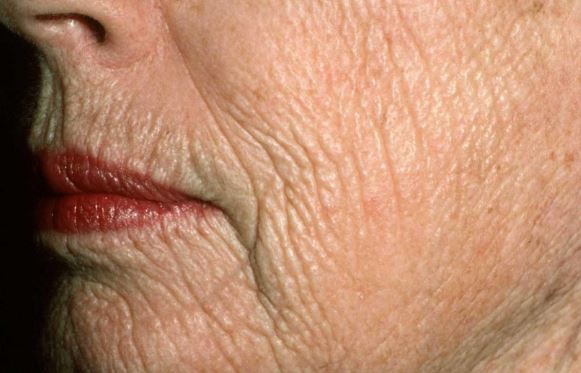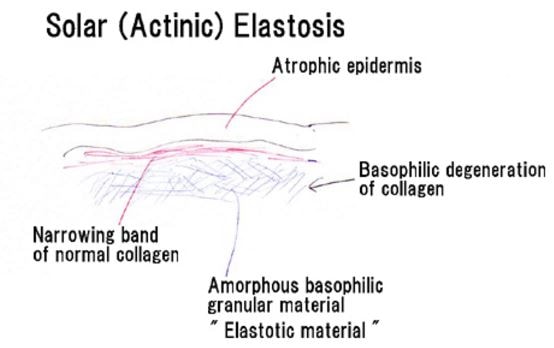Solar Elastosis
Solar Elastosis Definition
The term ‘Solar Elastosis’ is derived from two different terms. Solar term is related to sun and ‘elastosis’ term is related to elasticity. Solar elastosis can be defined as a condition, where the dermis layer of the skin, which is intact with elastic tissue becomes a degenerative condition due to lengthened sun exposure. This can affect all the skin types, but more fair skin people are more susceptible to this type of ‘photo-ageing’ condition. (1,2,3)

Solar Elastosis Symptoms
Solar elastosis is not a disease, but a symptom of photo-ageing. The impact of the prolonged exposure of sun can cause histological and clinical changes in the skin anatomy.
The histological changes in epidermal layer include degeneration or hyperplasia, stratum corneum becomes thickened, keratinized protein content increased and accumulated in the basement membrane and causes abnormal thickening of the skin, dermal papille layer becomes disappear, increase the number of pigmenting cells (melanocytes and melanosomes) and uneven distribution of melanin pigment.
Dermis layer is the most affected part of the skin anatomy with prolonged exposure to the sun. The included histological changes in the dermis layer are accumulation of degenerative products of collagen and elastin (esastic connective tissues) in the surface layer of the dermis. These increases the thickened elastic fibers and entangled in the broken part of fibrous tissues. This accumulation increases the thickness of the skin and tangled like broken shaped skin become prominent.
Clinical alterations of the skin condition due to photo-ageing , which is the main cause of solar elastosis due to prolonged exposure in the sun are described as changes develops in color, texture and moisture content of the skin.
A yellowish shade is observed with uneven pigmentation and teleagiectasia. These all are included in color changes.
Alteration of texture includes skin becomes thicken and rougher than the normal with fine prominent wrinkle lines and deep creases.
Skin becomes dry and no natural moisture level is maintained.
Precisely the included symptoms of Solar Elastosis’ are
- Hard & inelasticity
- Thicken noticeable yellow leathery skin in the subsequent part of the neck
- Thickening, and sometimes thinning skin layer at expose area
- Wrinkle,
- Dehydrated skinwith fine scaling,
- Erratichyper-pigmentation (2,3,4)
Causes
It is assumed that degradation of collagen and/or elastic fiber due to prolonged sun exposure is the cause of the accumulation of elastotic material in the innermost layer of the skin i.e. in the dermis. Fibroblast becomes overactive due to sun-damage and synthesize new elastic tissue, and promote an atypical artificial and degradative development (2).
The increase number of distorted collagens and elastic tissues causes reduction of the normal cellular structure of the dermis layer and increase the amount of waste materials and gradually these causes dilation of underlying blood vessels. Therefore, prolonged sun exposure or indirectly immense UV rays cause alteration of the dermal layer.
Other than this, different scientific literature explained that the how UV rays influence the degradative process. UV rays and IR rays and heat generated from sunlight cause an invasion of neutrophils, which are filled with neutrophil elastase (one type of proteolytic enzyme). The neutrophils are participating in the cellular damage process and mainly target elastic fibers and collagen degradation. The contribution of neutrophil elastase in solar elastosis is the major reason of photo-ageing process.
Furthermore, the UV radiation increases the oxidative stress by generating reactive oxygen species. The increased oxidative stress in another reason of skin damage by spoiling the molecular structure of the mitochondria and nuclear DNA. In addition, the progressive oxidative damage causes abnormal mutation in the DNA and it is hypothesized that the abnormal mutations are another contributory factor of photo-ageing. (3)

Diagnosis
The diagnosis of the solar elastosis is conducted by physical and clinical examinations. Thorough examinations of noticeable changes in the skin. On clinical examination, the sample of the skin layer is taken out for the laboratory tests.
In laboratory, microscopic analysis and skin biopsy are performed. The usual finding is the defeat of eosin staining of H&E sections. In addition, the upper dermis layer becomes bluish in color due to accumulation of irregularly thickened elastic fibres. These elastic fibres are responsible for the formation of disordered of tropoelastin and fibrillin tangled arrangement in the affected skin structure. (4)
Who are more susceptible?
Individuals who continuously expose to the sun at the day time due to occupational or other reason are more susceptible towards solar elastosis. The yellowish shade is more prominent for white skinned individuals.
Smoking influence the incidence rate of solar elastosis, as the tobacco smoking augment the synthesis of tropoelastin and matrix metalloproteinases (MMP), which affects the new collagen formation and promotes premature ageing of the skin. Tropoelastin and matrix metalloproteinases can cause of formation of degrade matrix proteins and generate atypical elastosis material in the dermis. This promotes the skin damage. (4)
Treatment
The available treatments of the solar elastosis are:
- Phototherapy
- Chemical peels
- Laser resurfaces
- Dermal filler
- Botox injection
These therapies provide mild effect on solar elastosis, as these may only effective to treat superficial layer of the skin (epidermis), but most of the cases they are ineffective in deepest layer (dermis) the skin. For an effective treatment combination of therapy is required, which promote correction of both epidermis and dermis layer. The combination therapy must concern the betterment of skin texture and skin tightening.
The following measures are helpful to prevent the solar elastosis:
- Avoidance of prolonged sun exposure at the day time
- Wear protective clothing and use accessories like umbrella, sunglass during roaming in day light
- Apply sufficient sunscreen or sun block lotion with sufficient Sun Protective Factor (SPF). (2,3,4)
References
- Corbalán-Vélez R,Ruiz-Macia JA, Brufau C, Oviedo-Ramírez I, Martínez-Barba E, López-Lozano JM, Carapeto FJ.; Solar elastosis in cutaneous squamous cell carcinoma; Actas Dermosifiliogr. 2010 Jul;101(6):517-23. Retrieve from: http://www.ncbi.nlm.nih.gov/pubmed/20738970
- Jun Khee Heng,*Derrick Chen Wee Aw, and Kong Bing Tan; Solar Elastosis in Its Papular Form: Uncommon, Mistakable; Case Rep Dermatol. 2014 Jan-Apr; 6(1): 124–128; Retrieve from: http://www.ncbi.nlm.nih.gov/pmc/articles/PMC4036135/
- Solar Skin Elastosis (2015); Retrieve from: http://www.medvspa.com/en/blog/1_70.html
4. Solar elastosis (2015); DermNet NZ; Retrieve from: http://www.dermnetnz.org/dermal-infiltrative/solar-elastosis.html
